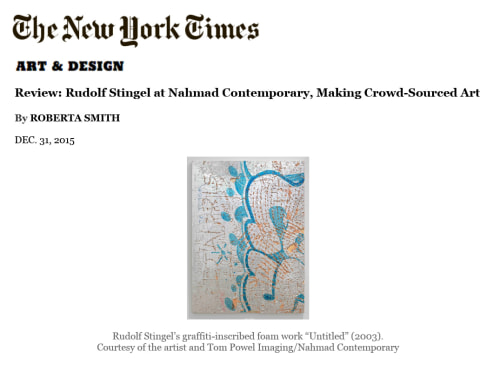
By Roberta Smith
By 2000, the Italian-born painter Rudolf Stingel had made what he called paintings by covering floors or walls with bright orange carpet, and had sold D.I.Y. abstract painting kits. He then began to adopt more traditional formats while maintaining his hands-off attitude. The results, as demonstrated by the 10 paintings from 2000 to 2003 in this exhibition, continue to startle, taunt and seduce.
Made of either Styrofoam or foil-covered insulation panels, these works hint at the violence of Lucio Fontana’s slashed canvases as well as the randomness of Jackson Pollock’s drip paintings, made using canvases placed on the floor. In the earliest series, Mr. Stingel walked repeatedly across big, thick slabs of Styrofoamwearing shoes dipped in acid, leaving frenzies of goofy Abominable Snowman footprints. They look so real as to be almost photographs; they also freeze performance into painting.
The second group is more chaotic. Here Mr. Stingel used silicone to glue sheets of Styrofoam to acid-resistant canvas. He then splashed this composite with acid, dissolving most of the Styrofoam and exposing the silicone as transparent paint, for an uncharacteristically decrepit, even abject, effect.
The best foil-foam works are flat-out gorgeous. Their shiny surfaces are pierced and scratched by all manner of graffiti by visitors to art galleries whose walls Mr. Stingel had lined with the insulation panels. When he was satisfied with the density of scratches, symbols and words, no more touching was allowed.
Acknowledging art’s long romance with street graffiti, these works are like crowd-sourced Cy Twombly paintings. They also personify the lush, sardonic beauty that is the wellspring of Mr. Stingel’s art. Rudolf Stingel ‘2000-2003’
Nahmad Contemporary
980 Madison Avenue, Upper East Side
Through Jan. 23